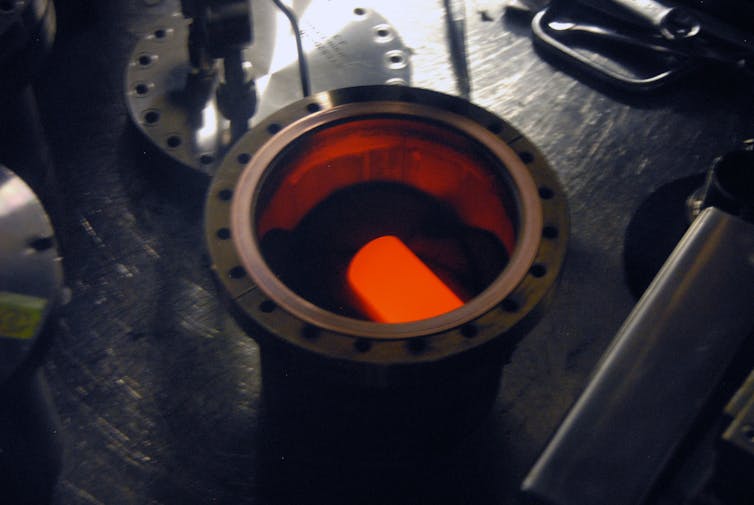Powering spacecraft with photo voltaic vitality might not look like a problem, given how intense the Solar’s mild can really feel on Earth. Spacecraft near the Earth use giant photo voltaic panels to harness the Solar for the electrical energy wanted to run their communications methods and science devices.
Nonetheless, the farther into area you go, the weaker the Solar’s mild turns into and the much less helpful it’s for powering methods with photo voltaic panels. Even within the interior photo voltaic system, spacecraft similar to lunar or Mars rovers want various energy sources.
As an astrophysicist and professor of physics, I train a senior-level aerospace engineering course on the area surroundings. One of many key classes I emphasize to my college students is simply how unforgiving area will be. On this excessive surroundings the place spacecraft should stand up to intense photo voltaic flares, radiation and temperature swings from lots of of levels beneath zero to lots of of levels above zero, engineers have developed revolutionary options to energy a number of the most distant and remoted area missions.
So how do engineers energy missions within the outer reaches of our photo voltaic system and past? The answer is know-how developed within the Nineteen Sixties primarily based on scientific rules found two centuries in the past: radioisotope thermoelectric generators, or RTGs.
RTGs are basically nuclear-powered batteries. However in contrast to the AAA batteries in your TV distant, RTGs can present energy for many years whereas lots of of tens of millions to billions of miles from Earth.
Nuclear energy
Radioisotope thermoelectric turbines don’t depend on chemical reactions like the batteries in your phone. As a substitute, they depend on the radioactive decay of parts to provide warmth and ultimately electrical energy. Whereas this idea sounds much like that of a nuclear power plant, RTGs work on a unique precept.
Most RTGs are constructed utilizing plutonium-238 as their supply of vitality, which isn’t usable for nuclear energy vegetation because it doesn’t maintain fission reactions. As a substitute, plutonium-238 is an unstable factor that may endure radioactive decay.
Radioactive decay, or nuclear decay, occurs when an unstable atomic nucleus spontaneously and randomly emits particles and vitality to succeed in a extra steady configuration. This course of typically causes the factor to alter into one other factor, because the nucleus can lose protons.
NASA
When plutonium-238 decays, it emits alpha particles, which encompass two protons and two neutrons. When the plutonium-238, which begins with 94 protons, releases an alpha particle, it loses two protons and turns into uranium-234, which has 92 protons.
These alpha particles work together with and switch vitality into the fabric surrounding the plutonium, which heats up that materials. The radioactive decay of plutonium-238 releases sufficient vitality that it could actually glow crimson from its personal warmth, and it’s this highly effective warmth that’s the vitality supply to energy an RTG.

Idaho National Laboratory, CC BY
Warmth as energy
Radioisotope thermoelectric turbines can flip warmth into electrical energy utilizing a precept referred to as the Seebeck impact, found by German scientist Thomas Seebeck in 1821. As an additional advantage, the warmth from some types of RTGs might help maintain electronics and the opposite parts of a deep-space mission heat and dealing properly.
In its fundamental type, the Seebeck impact describes how two wires of various conducting supplies joined in a loop produce a present in that loop when uncovered to a temperature distinction.
Units that use this precept are referred to as thermoelectric couples, or thermocouples. These thermocouples enable RTGs to provide electrical energy from the distinction in temperature created by the warmth of plutonium-238 decay and the frigid chilly of area.
Radioisotope thermoelectric generator design
In a fundamental radioisotope thermoelectric generator, you could have a container of plutonium-238, saved within the type of plutonium-dioxide, typically in a strong ceramic state that gives additional security within the occasion of an accident. The plutonium materials is surrounded by a protecting layer of foil insulation to which a big array of thermocouples is connected. The entire meeting is inside a protecting aluminum casing.
The inside of the RTG and one aspect of the thermocouples is saved sizzling – near 1,000 levels Fahrenheit (538 levels Celsius) – whereas the skin of the RTG and the opposite aspect of the thermocouples are uncovered to area. This exterior, space-facing layer will be as chilly as a few hundred degrees Fahrenheit below zero.
This robust temperature distinction permits an RTG to show the warmth from radioactive decay into electrical energy. That electrical energy powers all types of spacecraft, from communications methods to science devices to rovers on Mars, including five current NASA missions.
However don’t get too enthusiastic about shopping for an RTG for your own home. With the present know-how, they’ll produce solely a few hundred watts of power. That could be sufficient to energy an ordinary laptop computer, however not enough to play video games with a robust GPU.
For deep-space missions, nonetheless, these couple hundred watts are greater than sufficient.
The true advantage of RTGs is their potential to offer predictable, constant energy. The radioactive decay of plutonium is fixed – each second of on daily basis for many years. Over the course of about 90 years, only half the plutonium in an RTG could have decayed away. An RTG requires no transferring components to generate electrical energy, which makes them a lot much less more likely to break down or cease working.
Moreover, they’ve an excellent safety record, they usually’re designed to outlive their regular use and in addition be secure within the occasion of an accident.
RTGs in motion
RTGs have been key to the success of a lot of NASA’s photo voltaic system and deep-space missions. The Mars Curiosity and Perseverance rovers and the New Horizons spacecraft that visited Pluto in 2015 have all used RTGs. New Horizons is touring out of the photo voltaic system, the place its RTGs will present energy the place photo voltaic panels couldn’t.
Nonetheless, no missions seize the facility of RTGs fairly just like the Voyager missions. NASA launched the dual spacecraft Voyager 1 and Voyager 2 in 1977 to take a tour of the outer solar system after which journey past it.
Every craft was equipped with three RTGs, offering a complete of 470 watts of energy at launch. It has been nearly 50 years because the launch of the Voyager probes, and each are nonetheless energetic science missions, collecting and sending data back to Earth.
Voyager 1 and Voyager 2 are about 15.5 billion miles and 13 billion miles (almost 25 billion kilometers and 21 billion kilometers) from the Earth, respectively, making them the most distant human-made objects ever. Even at these excessive distances, their RTGs are nonetheless offering them constant energy.
These spacecraft are a testomony to the ingenuity of the engineers who first designed RTGs within the early Nineteen Sixties.
Benjamin Roulston, Assistant Professor of Physics, Clarkson University. This text is republished from The Conversation below a Artistic Commons license. Learn the original article.
![]()
Trending Merchandise

TP-Link AXE5400 Tri-Band WiFi 6E Router (Archer AXE75)- Gigabit Wireless Internet Router, ax Router for Gaming, VPN Router, OneMesh, WPA3, Black

ASUS TUF Gaming 24â (23.8â viewable) 1080P Monitor (VG249QL3A) – Full HD, 180Hz, 1ms, Fast IPS, ELMB, FreeSync Premium, G-SYNC Compatible, Speakers, DisplayPort, Height Adjustable, 3 Year Warranty

AOC 22B2HM2 22″ Full HD (1920 x 1080) 100Hz LED Monitor, Adaptive Sync, VGA x1, HDMI x1, Flicker-Free, Low Blue Light, HDR Ready, VESA, Tilt Adjust, Earphone Out, Eco-Friendly

MSI MAG Forge 321R Airflow – Premium Mid-Tower Gaming PC Case – Tempered Glass Side Panel – ARGB 120mm Fans – Liquid Cooling Support up to 360mm Radiator – Vented Front Panel

Lenovo Latest V15 Collection Laptop computer, 16GB RAM, 256GB SSD Storage, 15.6″ FHD Show with Low-Blue Gentle, Intel 4-Cores Upto 3.3Ghz Processor, HDMI, Ethernet Port, WiFi & Bluetooth, Home windows 11 Dwelling

15.6” Laptop computer 12GB DDR4 512GB SSD, Home windows 11 Quad-Core Intel Celeron N5095 Processors, 1080P IPS FHD Show Laptop computer Pc,Numeric Keypad USB 3.0, Bluetooth 4.2, 2.4/5G WiFi

Acer Aspire 5 15 Slim Laptop | 15.6″ FHD (1920 x 1080) IPS |Core i7-1355U | Intel Iris Xe Graphics | 16GB LPDDR5 | 512GB Gen 4 SSD | Wi-Fi 6E | USB4/Thunderbolt 4 | Backlit KB | A515-58M-7570, Gray








